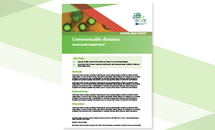Typhoid and paratyphoid fever - Annual Epidemiological Report for 2020
Typhoid and paratyphoid fevers are relatively rare in the European Union/European Economic Area (EU/EEA) and are mainly acquired during travel to countries outside the EU/EEA, particularly in South Asia.
Key facts
- Typhoid and paratyphoid fevers are relatively rare in the European Union/European Economic Area (EU/EEA) and are mainly acquired during travel to countries outside the EU/EEA, particularly in South Asia.
- For 2020, 17 EU/EEA countries reported a total of 315 cases.
- The EU/EEA notification rate declined by 64% in 2020 compared to the period 2016−2019 and was at the lowest ever level since the start of reporting in 2007. The decline was most likely due to the travel restrictions implemented during the COVID-19 pandemic, but also a result of the absence of UK data after their withdrawal from the EU, since the UK accounted for the second highest notification rates in the past.
- The usual seasonal pattern, with peaks in spring and late summer, was not observed in 2020. Instead, the highest case counts were reported in January, before declining, with only two smaller peaks in July and November.
- Of the 169 cases with information on travel status, 73.4% were travel-related, with India and Pakistan being the most common destinations.
- Although three vaccines against typhoid fever are available, it was still more frequently reported than paratyphoid fever, for which a vaccine is not yet available.
Download

Typhoid and paratyphoid fever - Annual Epidemiological Report 2020
- EN - [PDF-1.14 MB]







